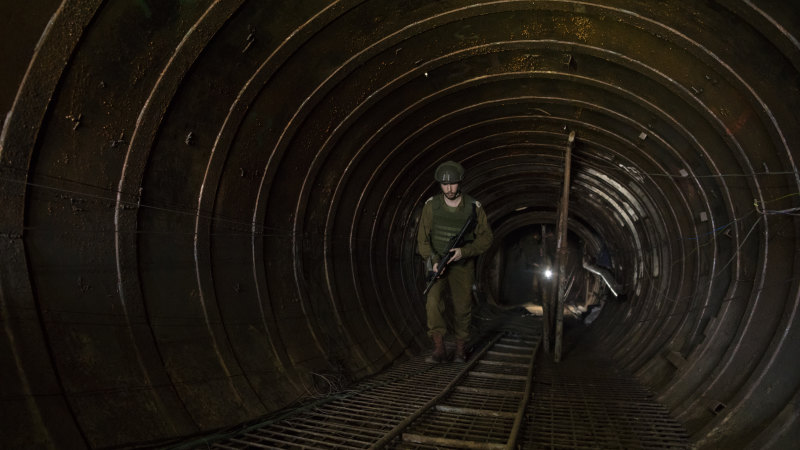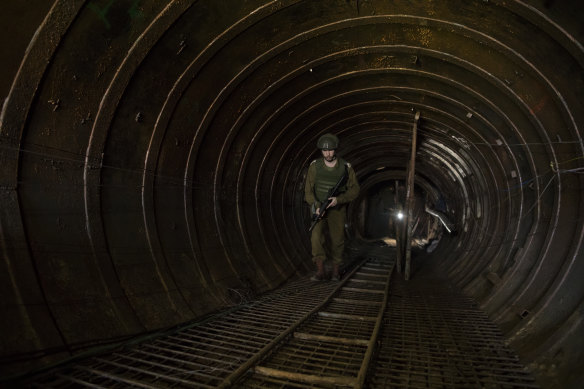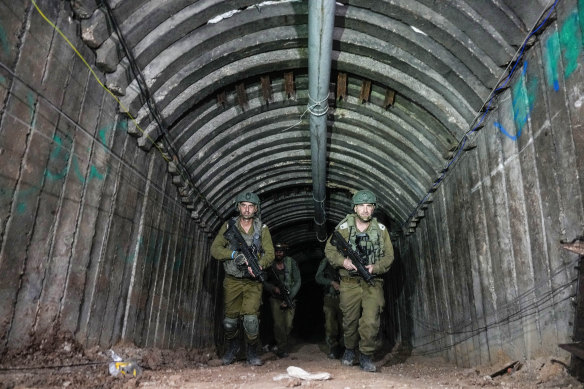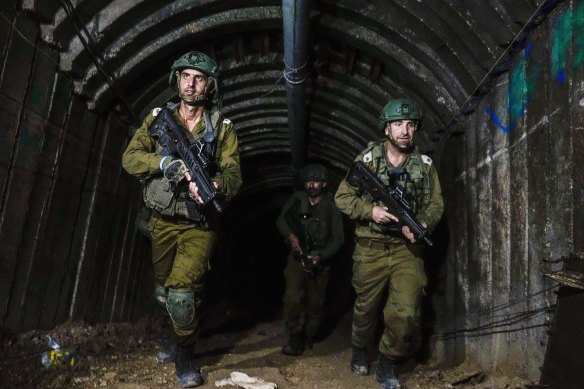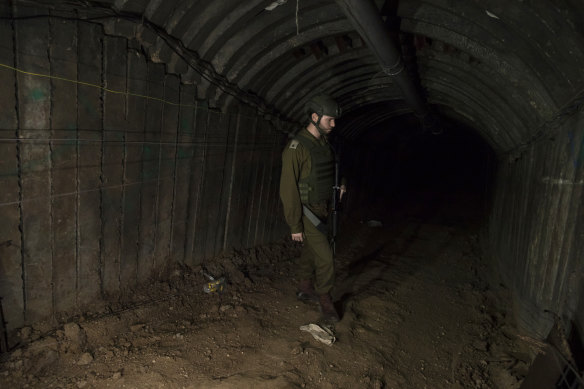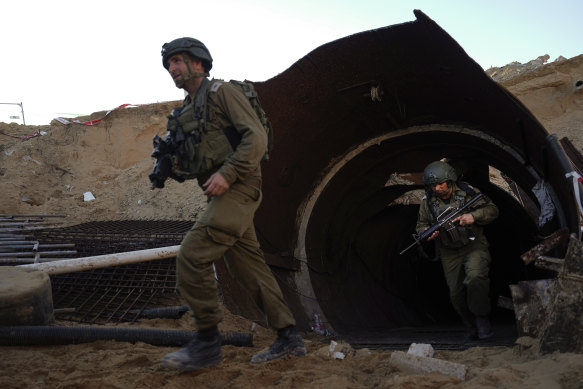Save articles for later
Add articles to your saved list and come back to them any time.
What strikes you first about the tunnel is its size. Jutting out from the desert sand at a gradient of about 25 degrees, the rusty tubular steel opening is just big enough to drive a car through.
That is far from an accident. Hamas, as it proved on October 7, is a mobile terror group and this vast tunnel network, running 50 metres deep in places and emerging just shy of the Erez Crossing at Gaza’s northern tip, is believed to have been designed for a wider invasion of Israel.
The Israel Defence Forces say this tunnel, in Gaza near the border with Israel, is the largest they’ve found yet.Credit: Getty
“From here you can be in Tel Aviv in 50 minutes and Jerusalem in an hour,” says one of the soldiers charged with taking us into it.
The Erez tunnel network is about four kilometres in length – the biggest discovered since the war started, according to the Israel Defence Forces (IDF).
At the entrance to the tunnel, we step over a pair of metre-square shafts that plummet vertically down. Steel ladders are pinned to the wall of each but you can’t see the bottom, giving a slight sense of vertigo as you enter.
A soldier to my right says he thinks the shafts were designed to collect sand that would otherwise fall inwards and block the main passage when the tunnel’s entrance was opened from within as part of a surprise attack. “We see the same in other attack tunnels,” he says.
The newly located tunnel is wide enough for a car to travel down.Credit: AP
He and his colleagues will destroy them with explosives along with the rest of the tunnel network once we’ve left.
For the first 10 or 15 metres, the walls are clad in the same steel sheet that is visible from the surface. It’s pitted and coloured with a deep rust, moisture from the thick air condensing against it. Further in, the sheeting gives way to hefty circular steel ribs before the walls straighten and the modular concrete arches seen in most other parts of the Gaza Metro take over.
Along the walls on either side, cables are slung for communications, lighting and power just like in a train tunnel. Deeper down, from about the point at which it starts to become harder to breathe, a plastic drainage pipe runs along the ceiling to provide ventilation.
As we move further underground, temperature and humidity rise quickly, and you can see why Hamas is desperate for fuel to power its oxygen generators and ventilation pumps.
Israeli forces planned to destroy the tunnel after showing it to the media.Credit: AP
Even just 50 or 60 metres in and perhaps 10 metres beneath the surface, the air is dank and sickly. Your heart rate picks up, not with physical excursion, but with the metabolic effect of your body sweating to try to cool itself in a super-humid environment.
The idea of running, let alone fighting down here seems impossible and you can see why IDF troops only enter as a last resort. The frame of anyone moving in from the light becomes a perfect silhouette. A single combatant with a rifle could hold off a commando unit for hours.
We don’t see them, but further in there are subsidiary tunnels running left and right, says the IDF. Off these there are various rooms for storage, command and control and accommodation. Many of the entrances are protected by hefty steel blast doors.
“This tunnel is connected to a wider total network that we have discovered in other areas”, says an IDF spokesman. “We found a large number of weapons inside the tunnel in depots ready to be used. It’s all around the tunnel.”
An Israeli soldier walks through the largest tunnel found in Gaza yet.Credit: Getty
The IDF believes the advance depositing of weapons in concealed areas above and below ground is one way in which Hamas managed to conceal its intentions ahead of October 7. “This is how they kept it a secret.” Fighters did not need to know in advance because the weapons depots were ready, the spokesman said.
While the main part of the tunnel was not used in the October 7 attack and is thought to have been kept secret for a separate assault, the IDF says other parts of the network were used to both stage the attack and retreat back into Gaza with hostages.
After her release at the end of October, 85-year-old Yocheved Lifshitz recounted being taken by her captors into a network of tunnels. “We went underground and walked for kilometres in wet tunnels, for two or three hours, in a spider’s web of tunnels,” she told journalists.
“We went through the tunnels until we reached a large hall. We were 25 people, and they separated us according to which kibbutz we were from.”
Israeli soldiers exit a tunnel that the military says Hamas militants used to attack the Erez crossing.Credit: AP
Other released hostages have described being held in rooms with little light or food. “Every day [in] there is like hell,” said 21-year-old Maya Regev. “Abnormal fear, zero sleep. At night the longings are crazy.”
The thud of heavy munitions hitting Gaza City could be heard in the distance when we were underground. The idea of that happening directly overhead while being held in anything like the Erez tunnel for months is the stuff of nightmares.
“Every day in captivity was extremely challenging. We were in tunnels, terrified that it would not be Hamas, but Israel, that would kill us, and then they would say Hamas killed you,” one freed hostage told Israeli Prime Minister Benjamin Netanyahu in an angry meeting with the hostage families two weeks ago.
The Telegraph, London
Get a note directly from our foreign correspondents on what’s making headlines around the world. Sign up for our weekly What in the World newsletter.
Most Viewed in World
From our partners
Source: Read Full Article
